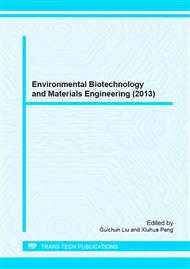[1]
D Alchin, Ion exchange resins(1992), on http: / nzic. org. nz/ ChemProcesses /water/13D. pdf.
Google Scholar
[2]
Orica Watercare Inc,Magnetic ion exchange resin exceeds EPA disinfection byproduct (DBP) standards,Filtration & Separation. 41 (2004) 28-30.
DOI: 10.1016/s0015-1882(04)00194-6
Google Scholar
[3]
H. Humbert, H. Gallard, H. Suty, and J. -P. Croue, Performance of selected anion exchange resins for the treatment of a high DOC content surface water, Water Research. 39 (2005) 1699-1708.
DOI: 10.1016/j.watres.2005.02.008
Google Scholar
[4]
C. Johnson, P. Singer, Impact of a magnetic ion exchange resin on ozone demand and bromate formation during drinking water treatment, Water Research. 68(2004) 134-151.
DOI: 10.1016/j.watres.2004.06.021
Google Scholar
[5]
D.A. Fearing, J. Banks, S. Guyetand, C.M. Eroles, B. Jefferson, D. Wilson, P. Hillis,A. Campbell, S.A. Parsons, Combination of ferric and MIEX for the treatment of a humic river water, Water Research. 38 (2004) 2551-2558.
DOI: 10.1016/j.watres.2004.02.020
Google Scholar
[6]
B. Murray, S. Pieterse, D. Raymer, C. Swartz, An evaluation of MIEX resin technology for potable treatment of highly coloured raw waters throughout the cape region of South Africa (2004).
Google Scholar
[7]
F.W. Pontius, N. Renouf, R. McCutchen, Magnetic ion exchange solves problems, American Water Works Association, Opflow. 29 (2006).
DOI: 10.1002/j.1551-8701.2006.tb01887.x
Google Scholar
[8]
B. Jefferson, et al, The effect of coagulant type on natural organic matter floc structure and strength (2004), 11th International Gothenburg Symposium, Orlando, Florida, US.
Google Scholar
[9]
M. Drikas, et al, The impact of recalcitrant organic matter of disinfection stability, THM formation potential and bacterial regrowth – An evaluation of magnetic ion exchange resin (MIEX) and alum coagulation, CRC WQT Occasional Paper 6(2003).
DOI: 10.2166/aqua.2003.0043
Google Scholar
[10]
L.R. Zappia, et al., The effect of MIEX on biofilm formation in the Wanneroodistribution system and biofilm formation at the Wanneroo groundwater treatmentplant( 2004), CSIRO Land and Water Consultancy Report.
Google Scholar
[11]
S. Snyder, E. Wert, J. Edwards, G. Budd, B. Long, D. Rexing, Magnetic Ion Exchange (MIEX) for the Removal of Endocrine Disrupting Chemicals and Pharmaceuticals (2002).
Google Scholar
[12]
R. Zhang, S. Vigneswaran, H H. Ngo, et al, Magnetic ion exchange (MIEX) resin as a pre-treatment to a submerged membrane system in the treatment of biologically treated wastewater[J], Desalination. 192(2006): 296-302.
DOI: 10.1016/j.desal.2005.07.040
Google Scholar
[13]
M . Bourke, MIEX Resin Pretreatment Followed by Microfiltration as an Alternative to Nanofiltration for DBP precursor Removal (2001), on http: / www. miexresin. com/ files/ publishedPapers/MIEXMFAWWAMTC01. pdf.
Google Scholar
[14]
R. Hopman, M.A. Meerkerk, W.G. Siegers, J.C. Kruithof, The prediction andoptimization of pesticide removal by GAC-filtration, Water Supply. 12(1994) (3-4)197-207.
Google Scholar
[15]
M. Drikas, M. Dixon, J.Y. Morran, The Impact of MIEX pretreatment on granular activated carbon performance(2005), Australian Water Quality Centre.
Google Scholar
[16]
R. Bian, Y. Watanabe, N. Tambo, G. Ozawa, Removal of Humic Substances by UF and NF Membrane Systems, Water Science Technology. 40(2000)121-129.
DOI: 10.2166/wst.1999.0458
Google Scholar
[17]
S.R. Gray, B.A. Bolto, Predicting NOM fouling rate of low pressure membranes (2003), Proc. International Membrane Science and Technology (IMSTEC), Sydney, Australia.
Google Scholar
[18]
C. Johnson, P. Singer, Impact of a magnetic ion exchange resin on ozone demand and bromate formation during drinking water treatment, Water Research. 68(2004) 134-151.
DOI: 10.1016/j.watres.2004.06.021
Google Scholar


